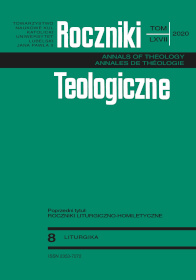Liturgische Texte zu Ehren der Heiligen Drei Könige (Teil 2)
Liturgical Texts Honoring the Three Holy Kings (Part 2)
Author(s): Teodor PuszczSubject(s): Christian Theology and Religion, Theology and Religion, Pastoral Theology
Published by: Towarzystwo Naukowe KUL & Katolicki Uniwersytet Lubelski Jana Pawła II
Keywords: Saint Three Kings; liturgy of the Church; Mass forms; pray for travelers and pilgrims
Summary/Abstract: In reference to my previous article (Roczniki Teologiczne, vol. 66, fasc. 8, 2019) it has to be said that liturgical texts honoring the Three Holy Kings as travelers and pilgrims form a part of the immense treasury of prayers of the Church for this type of liturgy. These holy men, alongside St. James the Greater, St. Raphael the Archangel, St. Julian, St. Christopher, and St. Nicholas, have been and still are seen as patrons of travelers and pilgrims. From this wealth of prayers, only a few remain in use in the post-Vatican II liturgy. It is surprising that the Missals of Cologne in the 15th and 16th century did not include the Mass De tribus regibus pro iter agentibus, when it could be found in medieval Missals practically everywhere in Europe. This article presents three more Masses. In its euchologion the Church recalls in the parts of this Mass, first the happy journey of the wise men from the East, guided by the extraordinary star to the newborn Messiah so as to present Him with extraordinary gifts, and it also recalls their return trip home. It then prays for the pilgrim faithful, through the intercession of these Holy Men, for a path that passes along the way of peace, health, and prosperity, and that Jesus Himself—the true Sun, true Star, and true Light—leads them to the yearned-for goal of their pilgrimage. The Church then asks for a divine companion along the way—an angel of peace—for the pilgrims, who will protect them from dangers to soul and body, and also from the onslaughts of Satan, that they may become companions of the Holy Spirit. At the end, the Church refers to the history of the Son of God, who was sent by the Father to the womb of the Virgin, who became Man, suffered and died; and again, to the angels at the grave, witnesses of His resurrection. The role of the angles is prolonged and manifested in their day and night care over pilgrims—for which the Church also prays. The text of the first reading comes from a passage from the prophet Isaiah (Isa 60:1-6) which talks about a pilgrimage of the nations with gifts to Jerusalem and to the light, that is, to the Lord. A similar section in the Book of Genesis tells of the journey of Abraham in the company of an angel to his new homeland (Gen 24:7). Both of these texts create a bridge to the next two pericopes, which describe the journey of the Magi, with their gifts, from the East to Bethlehem, to the Son of God (Matt 2:1-12) and also the missionary command to the apostles place their trust in the help of God along their way (Matt 10:7-8), which is a typical theme in pilgrimages. The sources for the Mass antiphons (introitus, graduale, offertorium i communio) are passages from the Psalms and other Books of the Bible that constitute the readings of the Mass, hence the recurring themes of: being guided by God along one’s pathway, trust in God, the star in the East, the journey of the Magi with gifts, and adoration of the King of kings. The sequence has ten verses and is a non-biblical text. First, those gathered are encouraged to praise the majesty of God, then the text touches on the birth of Christ and the adoration of the wise men with their gifts, the mystical significance of which is explained (verses 1-5). The following verses recall the transfer of their relics and their cult in Cologne (verses 6-9). At the end, there is a supplication that Christ, through the intercession of the wise men, may lead the faithful to eternal life (verse 10).
Journal: Roczniki Teologiczne
- Issue Year: 67/2020
- Issue No: 8
- Page Range: 75-92
- Page Count: 18
- Language: German

